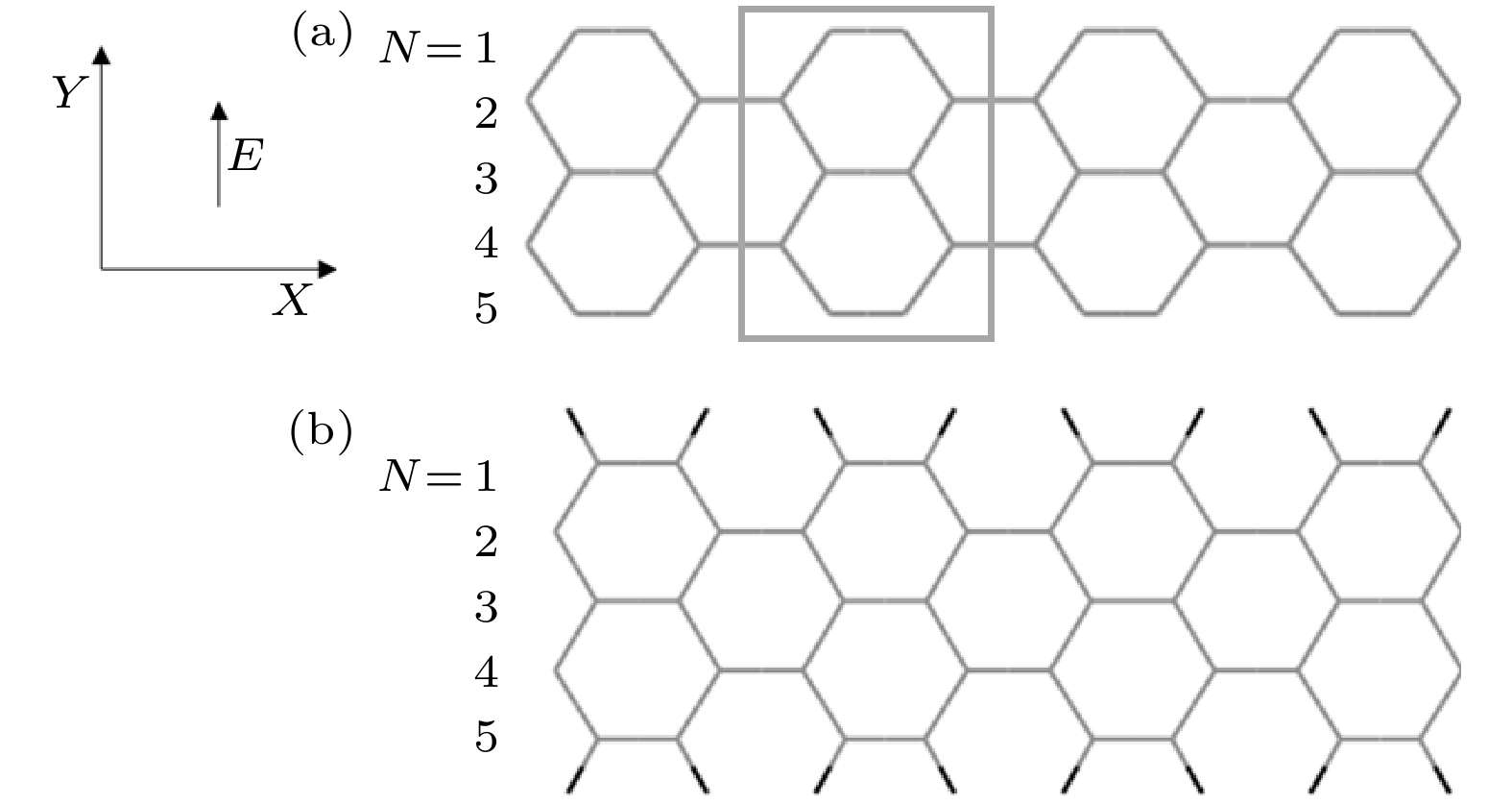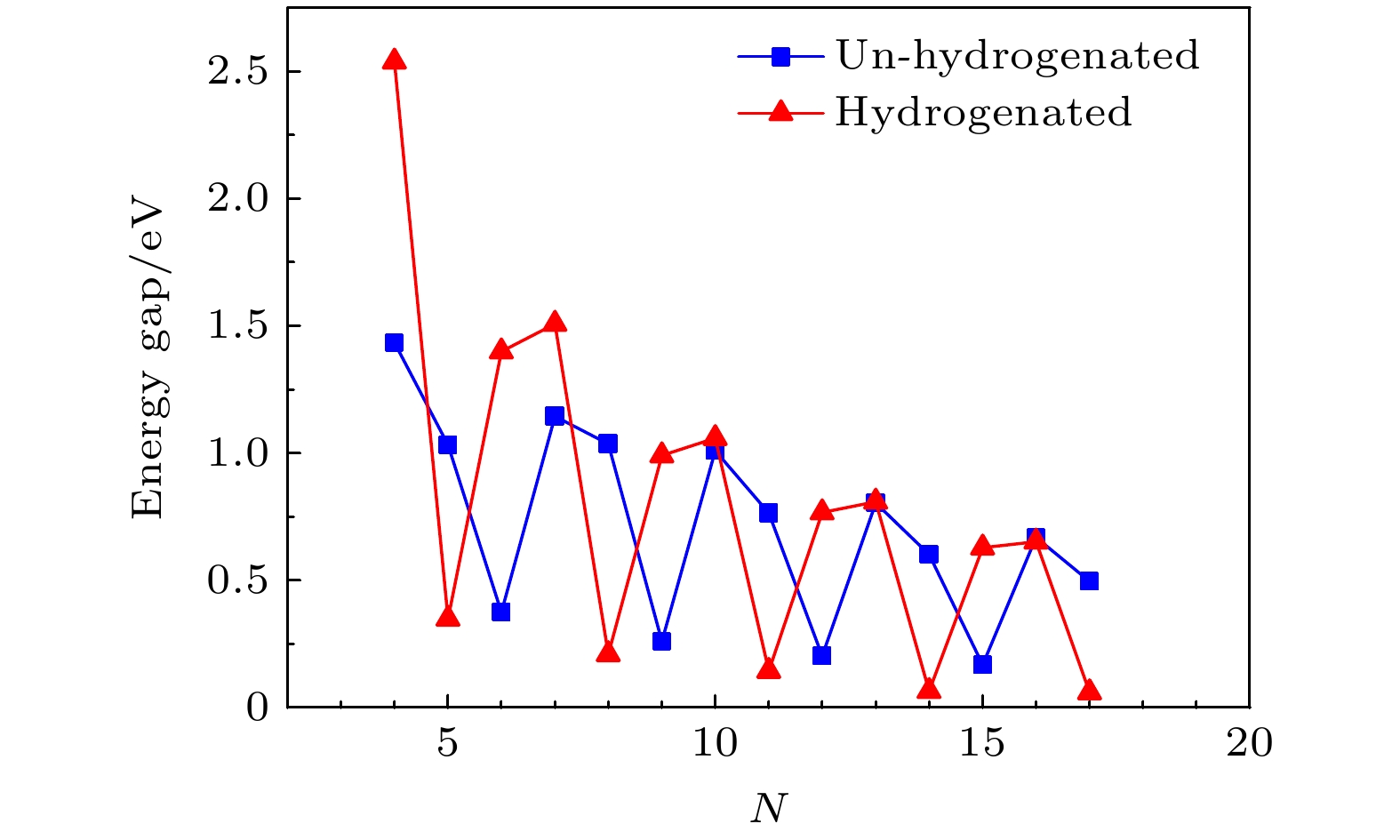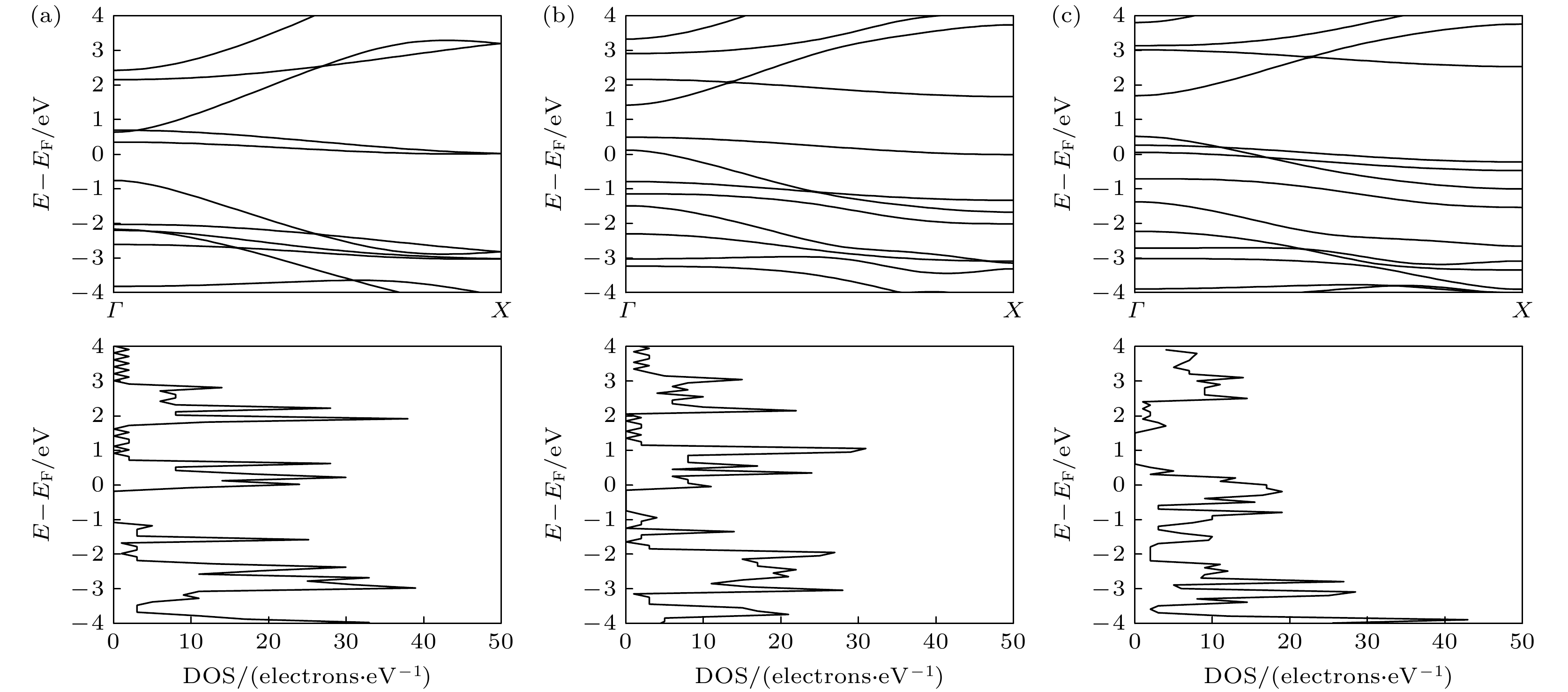-
采用基于密度泛函理论的紧束缚方法计算研究了外加横向电场对边缘未加氢/加氢钝化的扶手椅型石墨烯纳米带的电子结构及电子布居数的影响. 计算结果表明, 石墨烯纳米带的能隙变化受其宽带影响. 当施加沿其宽度方向的横向外加电场时, 纳米带的能带结构及态密度都会产生较大的变化. 对于具有半导体性的边缘未加氢纳米带, 随着所施加电场强度的增加, 会发生半导体-金属的转变. 同时, 电场也会对能级分布产生显著影响. 外加电场导致纳米带内原子上电子布居数分布失去对称性, 电场强度越大, 其布居数不对称性越明显. 边缘加氢钝化可以显著改变纳米带内原子上的布居数分布.
In recent years, the rapid development of electronic information technology has brought tremendous convenience to people’s lives, and the devices used have become increasingly miniaturized. However, due to the constraints of the process and the material itself, as the size of the devices made of silicon materials is further reduced, obvious short channel effects and dielectric tunneling effects will appear, which will affect the normal operations of these devices. In order to overcome this development bottleneck, it is urgent to find new materials for the devices that can replace silicon. Carbon has the same outer valence electron structure as silicon. Since 2004, Geim [Novoselov K S, Geim A K, Morozov S V, et al. 2005 Nature 438 197] prepared two-dimensional graphene with a honeycomb-like planar structure formed by sp2 hybridization, graphene has received extensive attention from researchers and industrial circles for its excellent electronic and mechanical properties. However, graphene is not a true semiconductor, and it has no band gap in its natural state. The energy gap can be opened by preparing graphene nanoribbons. On this basis, the electronic structure of the nanoribbons can be further controlled by using an external electric field to destroy the symmetric structure of the nanoribbons. In this paper, the tight-binding method based on density functional theory is used to calculate and study the influence of external transverse electric field on the electronic structure and electron population of un-hydrogenated/hydrogenated armchair graphene nanoribbons. The calculation results show that whether there is hydrogen on the edge of the graphene nanoribbons or not, the energy gap changed at the Г point shows a three-group periodic oscillation decreasing law, and as N increases, the energy gap will disappear. Under the external electric field, the band structure and the density of states of the nanoribbons will change greatly. For un-hydrogenated nanoribbons with semiconducting properties, as the intensity of the external electric field increases, a semiconductor-metal transition occurs. At the same time, the electric field will also have a significant influence on the energy level distribution, resulting in significant changes in the peak height and peak position of the density of states. The external electric field causes the electron population distribution on the atoms in the nanoribbons to break its symmetry. The greater the electric field strength, the more obvious the population asymmetry is. The edge hydrogenation passivation can significantly change the population distribution of atoms in nanoribbons. -
Keywords:
- graphene /
- nanoribbons /
- electronic structure /
- external electric field
[1] Novoselov K S, Geim A K, Morozov S V, Jiang D, Zhang Y, Dubonos S V, Grigorieva I V, Firsov A A 2004 Science 306 666
 Google Scholar
Google Scholar
[2] Schwierz F 2010 Nat. Nanotechnol. 5 487
 Google Scholar
Google Scholar
[3] Novoselov K S, Geim A K, Morozov S V, Jiang D, Katsnelson M I, Grigorieva I V, Dubonos S V, Firsov A A 2005 Nature 438 197
 Google Scholar
Google Scholar
[4] Lee C, Wei X, Kysar J W, Hone J 2008 Science 321 385
 Google Scholar
Google Scholar
[5] Balandin A A, Ghosh S, Bao W Z, Calizo I, Teweldebrhan D, Miao F, Lau C N 2008 Nano Lett. 8 902
 Google Scholar
Google Scholar
[6] Nair R R, Blake P, Grigorenko A N, Novoselov K S, Booth T J, Stauber T, Peres N M R, Geim A K 2008 Science 320 1308
 Google Scholar
Google Scholar
[7] Son Y W, Cohen M L, Louie S G 2006 Phys. Rev. Lett. 97 216803
 Google Scholar
Google Scholar
[8] Fujita M, Wakabayashi K, Nakada K, Kusakabe K 1996 J. Phys. Soc. Jpn. 65 1920
 Google Scholar
Google Scholar
[9] Huang B, Yan Q M, Li Z Y, Duan W H 2009 Front. Phys. China 4 269
 Google Scholar
Google Scholar
[10] Wang G 2012 Chem. Phys. Lett. 533 74
 Google Scholar
Google Scholar
[11] Barone, Verónica, Hod O, Scuseria G E 2006 Nano Lett. 6 2748
 Google Scholar
Google Scholar
[12] Jaiswal M, Haley Y X L C, Bao Q 2011 ACS Nano 5 888
 Google Scholar
Google Scholar
[13] Cai J, Ruffieux P, Jaafar R, Bieri M, Braun T, Blankenburg S, Muoth M, Seitsonen A P, Saleh M, Feng X, Müllen K, Fasel R 2010 Nature 466 470
 Google Scholar
Google Scholar
[14] Zhang H, Lin H, Sun K, Chen L, Zagranyarski Y, Aghdassi N, Duhm S, Li Q, Zhong D, Li Y, Müllen K, Fuchs H, Chi L 2015 J. Am. Chem. Soc. 137 4022
 Google Scholar
Google Scholar
[15] Kimouche A, Ervasti M M, Drost R, Halonen S, Harju A, Joensuu P M, Sainio J, Liljeroth P 2015 Nat. Commun. 6 10177
 Google Scholar
Google Scholar
[16] Basagni A, Sedona F, Pignedoli C A, Cattelan M, Nicolas L, Casarin M, Sambi M 2015 J. Am. Chem. Soc. 137 1802
 Google Scholar
Google Scholar
[17] Ruffieux P, Cai J, Plumb N C, Patthey L, Prezzi D, Ferretti A, Molinari E, Feng X, Müllen K, Pignedoli C A, Fasel R 2012 ACS Nano 6 6930
 Google Scholar
Google Scholar
[18] Talirz L, Sode H, Dumslaff T, Wang S, Sanchez-Valencia J R, Liu J, Shinde P, Pignedoli C A, Liang L, Meunier V, Plumb N C, Shi M, Feng X, Narita A, Müllen K, Fasel R, Ruffieux P 2017 ACS Nano 11 1380
 Google Scholar
Google Scholar
[19] Chen Y C, de Oteyza D G, Pedramrazi Z, Chen C, Fischer F R, Crommie M F 2013 ACS Nano 7 6123
 Google Scholar
Google Scholar
[20] Abdurakhmanova N, Amsharov N, Stepanow S, Jansen M, Kern K, Amsharov K 2014 Carbon 77 1187
 Google Scholar
Google Scholar
[21] Huang H, Wei D, Sun J, Wong S L, Feng Y P, Neto A H C, Wee A T S 2012 Sci. Rep. 2 983
 Google Scholar
Google Scholar
[22] Ellert C, Corkum P B 1999 Phys. Rev. A 59 R3170
 Google Scholar
Google Scholar
[23] 王藩侯, 黄多辉, 杨俊升 2013 物理学报 62 07310
 Google Scholar
Google Scholar
Wang F H, Huang D H, Yang J S 2013 Acta Phys. Sin. 62 07310
 Google Scholar
Google Scholar
[24] Rai D, Joshi H, Kulkarni A D, Gejji S P, Pathak R K 2007 J. Phys. Chem. A 111 9111
 Google Scholar
Google Scholar
[25] 李亚莎, 谢云龙, 黄太焕, 徐程, 刘国成 2018 物理学报 67 183101
 Google Scholar
Google Scholar
Li Y S, Xie Y L, Huang T H, Xu C, Liu G C 2018 Acta Phys. Sin. 67 183101
 Google Scholar
Google Scholar
[26] 杜建宾, 冯志芳, 韩丽君, 唐延林, 武德起 2018 物理学报 67 223101
 Google Scholar
Google Scholar
Du J B, Feng Z F, Han L J, Tang Y L, Wu D Q 2018 Acta Phys. Sin. 67 223101
 Google Scholar
Google Scholar
[27] 李世雄, 吴永刚, 令狐荣锋, 孙光宇, 张正平, 秦水介 2015 物理学报 64 043101
 Google Scholar
Google Scholar
Li S X, Wu Y G, Linghu R F, Sun G Y, Zhang Z P, Qin S J 2015 Acta Phys. Sin. 64 043101
 Google Scholar
Google Scholar
[28] 徐国亮, 谢会香, 袁伟, 张现周, 刘玉芳 2012 物理学报 61 043104
 Google Scholar
Google Scholar
Xu G L, Xie H X, Yuan W, Zhang X Z, Liu Y F 2012 Acta Phys. Sin. 61 043104
 Google Scholar
Google Scholar
[29] 曹欣伟, 任杨, 刘慧, 李姝丽 2014 物理学报 63 043101
 Google Scholar
Google Scholar
Cao X W, Ren Y, Liu H, Li S L 2014 Acta Phys. Sin. 63 043101
 Google Scholar
Google Scholar
[30] Son Y W, Cohen M L, Louie S G 2006 Nature 444 347
 Google Scholar
Google Scholar
[31] Chang C P, Huang Y C, Lu C L, Ho J H, Li T S, Lin M F 2006 Carbon 44 508
 Google Scholar
Google Scholar
[32] Chen S C, Chang C P, Lee C H, Lin M F 2010 J. Appl. Phys. 107 4579
 Google Scholar
Google Scholar
[33] Wu L J, Zhang L, Qi Y 2017 Sci. Adv. Mater. 9 1775
 Google Scholar
Google Scholar
[34] Wu L J, Zhang L, Shen L H 2018 Appl. Surf. Sci. 447 22
 Google Scholar
Google Scholar
[35] Wu L J, Dong Y, Springborg M, Zhang L, Yang Qi 2015 Comp. Theo. Chem. 1074 185
 Google Scholar
Google Scholar
[36] Wu L J, Xu X M, Zhang L, Qi Y 2019 Superlattice Microst. 135 106261
 Google Scholar
Google Scholar
[37] 吴丽君, 随强涛, 张多, 张林, 祁阳 2015 物理学报 64 42102
 Google Scholar
Google Scholar
Wu L J, Sui Q T, Zhang D, Zhang L, Qi Y 2015 Acta. Phys. Sin. 64 42102
 Google Scholar
Google Scholar
[38] Hourahine B, Aradi B, Blum V, et al. 2020 J. Chem. Phys. 152 124101
 Google Scholar
Google Scholar
[39] Elstner M, Porezag D, Jungnickel G, Elsner J, Haugk M, Frauenheim T, Suhai S, Seifert G 1998 Phys. Rev. B 58 7260
 Google Scholar
Google Scholar
[40] Witek H, Irle S, Morokuma K 2004 J. Chem. Phys. 121 5163
 Google Scholar
Google Scholar
[41] Mulliken R S 2004 J. Chem. Phys. 23 1841
 Google Scholar
Google Scholar
[42] Elstner M 1998 Ph. D. Dissertation (Germany: University of Paderborn)
[43] Raza H, Kan E C 2008 Phys. Rev. B 77 245434
 Google Scholar
Google Scholar
-
-
[1] Novoselov K S, Geim A K, Morozov S V, Jiang D, Zhang Y, Dubonos S V, Grigorieva I V, Firsov A A 2004 Science 306 666
 Google Scholar
Google Scholar
[2] Schwierz F 2010 Nat. Nanotechnol. 5 487
 Google Scholar
Google Scholar
[3] Novoselov K S, Geim A K, Morozov S V, Jiang D, Katsnelson M I, Grigorieva I V, Dubonos S V, Firsov A A 2005 Nature 438 197
 Google Scholar
Google Scholar
[4] Lee C, Wei X, Kysar J W, Hone J 2008 Science 321 385
 Google Scholar
Google Scholar
[5] Balandin A A, Ghosh S, Bao W Z, Calizo I, Teweldebrhan D, Miao F, Lau C N 2008 Nano Lett. 8 902
 Google Scholar
Google Scholar
[6] Nair R R, Blake P, Grigorenko A N, Novoselov K S, Booth T J, Stauber T, Peres N M R, Geim A K 2008 Science 320 1308
 Google Scholar
Google Scholar
[7] Son Y W, Cohen M L, Louie S G 2006 Phys. Rev. Lett. 97 216803
 Google Scholar
Google Scholar
[8] Fujita M, Wakabayashi K, Nakada K, Kusakabe K 1996 J. Phys. Soc. Jpn. 65 1920
 Google Scholar
Google Scholar
[9] Huang B, Yan Q M, Li Z Y, Duan W H 2009 Front. Phys. China 4 269
 Google Scholar
Google Scholar
[10] Wang G 2012 Chem. Phys. Lett. 533 74
 Google Scholar
Google Scholar
[11] Barone, Verónica, Hod O, Scuseria G E 2006 Nano Lett. 6 2748
 Google Scholar
Google Scholar
[12] Jaiswal M, Haley Y X L C, Bao Q 2011 ACS Nano 5 888
 Google Scholar
Google Scholar
[13] Cai J, Ruffieux P, Jaafar R, Bieri M, Braun T, Blankenburg S, Muoth M, Seitsonen A P, Saleh M, Feng X, Müllen K, Fasel R 2010 Nature 466 470
 Google Scholar
Google Scholar
[14] Zhang H, Lin H, Sun K, Chen L, Zagranyarski Y, Aghdassi N, Duhm S, Li Q, Zhong D, Li Y, Müllen K, Fuchs H, Chi L 2015 J. Am. Chem. Soc. 137 4022
 Google Scholar
Google Scholar
[15] Kimouche A, Ervasti M M, Drost R, Halonen S, Harju A, Joensuu P M, Sainio J, Liljeroth P 2015 Nat. Commun. 6 10177
 Google Scholar
Google Scholar
[16] Basagni A, Sedona F, Pignedoli C A, Cattelan M, Nicolas L, Casarin M, Sambi M 2015 J. Am. Chem. Soc. 137 1802
 Google Scholar
Google Scholar
[17] Ruffieux P, Cai J, Plumb N C, Patthey L, Prezzi D, Ferretti A, Molinari E, Feng X, Müllen K, Pignedoli C A, Fasel R 2012 ACS Nano 6 6930
 Google Scholar
Google Scholar
[18] Talirz L, Sode H, Dumslaff T, Wang S, Sanchez-Valencia J R, Liu J, Shinde P, Pignedoli C A, Liang L, Meunier V, Plumb N C, Shi M, Feng X, Narita A, Müllen K, Fasel R, Ruffieux P 2017 ACS Nano 11 1380
 Google Scholar
Google Scholar
[19] Chen Y C, de Oteyza D G, Pedramrazi Z, Chen C, Fischer F R, Crommie M F 2013 ACS Nano 7 6123
 Google Scholar
Google Scholar
[20] Abdurakhmanova N, Amsharov N, Stepanow S, Jansen M, Kern K, Amsharov K 2014 Carbon 77 1187
 Google Scholar
Google Scholar
[21] Huang H, Wei D, Sun J, Wong S L, Feng Y P, Neto A H C, Wee A T S 2012 Sci. Rep. 2 983
 Google Scholar
Google Scholar
[22] Ellert C, Corkum P B 1999 Phys. Rev. A 59 R3170
 Google Scholar
Google Scholar
[23] 王藩侯, 黄多辉, 杨俊升 2013 物理学报 62 07310
 Google Scholar
Google Scholar
Wang F H, Huang D H, Yang J S 2013 Acta Phys. Sin. 62 07310
 Google Scholar
Google Scholar
[24] Rai D, Joshi H, Kulkarni A D, Gejji S P, Pathak R K 2007 J. Phys. Chem. A 111 9111
 Google Scholar
Google Scholar
[25] 李亚莎, 谢云龙, 黄太焕, 徐程, 刘国成 2018 物理学报 67 183101
 Google Scholar
Google Scholar
Li Y S, Xie Y L, Huang T H, Xu C, Liu G C 2018 Acta Phys. Sin. 67 183101
 Google Scholar
Google Scholar
[26] 杜建宾, 冯志芳, 韩丽君, 唐延林, 武德起 2018 物理学报 67 223101
 Google Scholar
Google Scholar
Du J B, Feng Z F, Han L J, Tang Y L, Wu D Q 2018 Acta Phys. Sin. 67 223101
 Google Scholar
Google Scholar
[27] 李世雄, 吴永刚, 令狐荣锋, 孙光宇, 张正平, 秦水介 2015 物理学报 64 043101
 Google Scholar
Google Scholar
Li S X, Wu Y G, Linghu R F, Sun G Y, Zhang Z P, Qin S J 2015 Acta Phys. Sin. 64 043101
 Google Scholar
Google Scholar
[28] 徐国亮, 谢会香, 袁伟, 张现周, 刘玉芳 2012 物理学报 61 043104
 Google Scholar
Google Scholar
Xu G L, Xie H X, Yuan W, Zhang X Z, Liu Y F 2012 Acta Phys. Sin. 61 043104
 Google Scholar
Google Scholar
[29] 曹欣伟, 任杨, 刘慧, 李姝丽 2014 物理学报 63 043101
 Google Scholar
Google Scholar
Cao X W, Ren Y, Liu H, Li S L 2014 Acta Phys. Sin. 63 043101
 Google Scholar
Google Scholar
[30] Son Y W, Cohen M L, Louie S G 2006 Nature 444 347
 Google Scholar
Google Scholar
[31] Chang C P, Huang Y C, Lu C L, Ho J H, Li T S, Lin M F 2006 Carbon 44 508
 Google Scholar
Google Scholar
[32] Chen S C, Chang C P, Lee C H, Lin M F 2010 J. Appl. Phys. 107 4579
 Google Scholar
Google Scholar
[33] Wu L J, Zhang L, Qi Y 2017 Sci. Adv. Mater. 9 1775
 Google Scholar
Google Scholar
[34] Wu L J, Zhang L, Shen L H 2018 Appl. Surf. Sci. 447 22
 Google Scholar
Google Scholar
[35] Wu L J, Dong Y, Springborg M, Zhang L, Yang Qi 2015 Comp. Theo. Chem. 1074 185
 Google Scholar
Google Scholar
[36] Wu L J, Xu X M, Zhang L, Qi Y 2019 Superlattice Microst. 135 106261
 Google Scholar
Google Scholar
[37] 吴丽君, 随强涛, 张多, 张林, 祁阳 2015 物理学报 64 42102
 Google Scholar
Google Scholar
Wu L J, Sui Q T, Zhang D, Zhang L, Qi Y 2015 Acta. Phys. Sin. 64 42102
 Google Scholar
Google Scholar
[38] Hourahine B, Aradi B, Blum V, et al. 2020 J. Chem. Phys. 152 124101
 Google Scholar
Google Scholar
[39] Elstner M, Porezag D, Jungnickel G, Elsner J, Haugk M, Frauenheim T, Suhai S, Seifert G 1998 Phys. Rev. B 58 7260
 Google Scholar
Google Scholar
[40] Witek H, Irle S, Morokuma K 2004 J. Chem. Phys. 121 5163
 Google Scholar
Google Scholar
[41] Mulliken R S 2004 J. Chem. Phys. 23 1841
 Google Scholar
Google Scholar
[42] Elstner M 1998 Ph. D. Dissertation (Germany: University of Paderborn)
[43] Raza H, Kan E C 2008 Phys. Rev. B 77 245434
 Google Scholar
Google Scholar
计量
- 文章访问数: 10548
- PDF下载量: 233
- 被引次数: 0














 下载:
下载:







